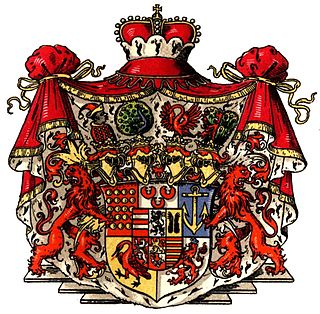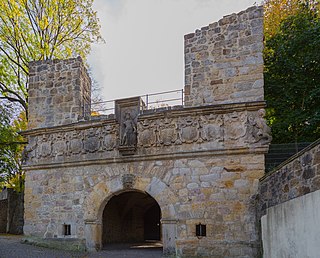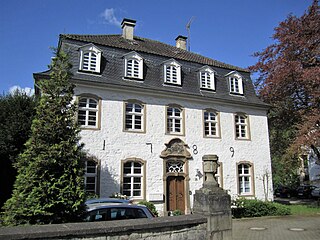Bentheim-Steinfurt was a historical county located in northwestern North Rhine-Westphalia in the region surrounding Steinfurt, Germany. Bentheim-Steinfurt was a partition of Bentheim-Bentheim, itself a partition of the County of Bentheim. Bentheim-Steinfurt was partitioned: between itself and Bentheim-Tecklenburg-Rheda in 1606; and between itself and Bentheim-Bentheim in 1643.

Bentheim-Tecklenburg was a German county based in the region around Tecklenburg in northern North Rhine-Westphalia, Germany.

The County of Bentheim was a state of the Holy Roman Empire, located in the south-west corner of today's Lower Saxony, Germany. The county's borders corresponded largely to those of the modern administrative district (Landkreis) of Grafschaft Bentheim.

Hagen-Hohenlimburg, on the Lenne river, is a borough of the city of Hagen in North Rhine-Westphalia, Germany.

Tecklenburg Castle, or simply the Tecklenburg, is a ruined castle and venue for the Tecklenburg Open-Air Theatre in the eponymous town of Tecklenburg in the county of Steinfurt in the state of North Rhine-Westphalia, Germany. It was once the seat of the rulers of the County of Tecklenburg.
Alexius Frederick, Prince of Bentheim and Steinfurt was a German nobleman.

Countess Palatine Dorothea of Simmern was a Countess Palatine of Simmern by birth and Princess of Anhalt-Dessau by marriage.

Otto, Count of Lippe-Brake was the first ruling Count of Lippe-Brake.

Elsey Abbey, earlier Elsey Priory is a former women's religious house located near Elsey, now part of Hohenlimburg, Hagen, Germany.

Arnold III of Bentheim-Tecklenburg-Steinfurt-Limburg was a German nobleman. He was Count of Bentheim, Tecklenburg and Steinfurt, and jure uxoris Count of Limburg. He ruled as Arnold IV in Bentheim and Tecklenburg, and as Arnold II in Steinfurt. In Limburg, he was the first Count named Arnold and hence just the name distinctive.
Magdalena of Neuenahr-Alpen was a German noblewoman. She was the heiress of the House of Neuenahr-Alpen; she inherited the County of Limburg. By marriage, she was Countess of Tecklenburg.

Eberwin III, Count of Bentheim-Steinfurt was a German nobleman. He was a member of the elder line of the House of Bentheim-Steinfurt and was the ruling Count of Bentheim and Steinfurt from 1544 until his death. From 1557, he was also Count of Tecklenburg and Lord of Rheda by marriage.

Anna, Princess of Anhalt-Bernburg was the consort of Christian I, Prince of Anhalt-Bernburg.

Diederik III of Limburg Hohenlimburg, born around 1328, was the eldest son of Everhard II van Limburg Hohenlimburg and Juta of Sayn. His father Everhard died on 11 November 1344. Twenty years later he followed the 9th of August 1364 his grandfather Diederik II count of Limburg Hohenlimburg. In 1366 Diederik III became the Amtmann of Angermünde, the district between Duisburg and Düsseldorf. As the successor to lord Diederik III of Broich, who five years later would become his father-in-law. He also was Voght of the Rellinghausen Abbey. On 3 July 1371. Diederik married Ludgardis (Lukarda) daughter of Diederik of Broich and Katharina of Steinfurt. Lukarda was heiress of the Lordship Broich. At his wedding, he receives a dowry of 1,600 old gold shields.

The brothers counts Willem II and Hendrik I, sons of Diederick IV count of Limburg Hohenlimburg Broich and Lukardis of Broich succeed each other as Count of Limburg Hohenlimburg Broich. In 1446, two years after the death of their father Diederick. The Archbishop of Cologne, after the conquest of Broich castle handed over his share of Broich to Willem II of Limburg. The Duke of Gullick-Berg also returned his share of Broich. Willem had to reconfirm provisions that his father Diederik IV had agreed upon in 1430. Brother Hendrik of Limburg continued to fight for the Cleves party. It was not until April 7, 1454, that he agreed to waiver of his Lordship rights to Broich.
Anna von Tecklenburg-Schwerin (1532-1582) was the ruling suo jure Countess of Tecklenburg and the lordships of Wevelinghoven and Rheda between 1557 and 1582. She was regent of the County of Bentheim-Steinfurt during the minority of her son in 1562–1573.



















